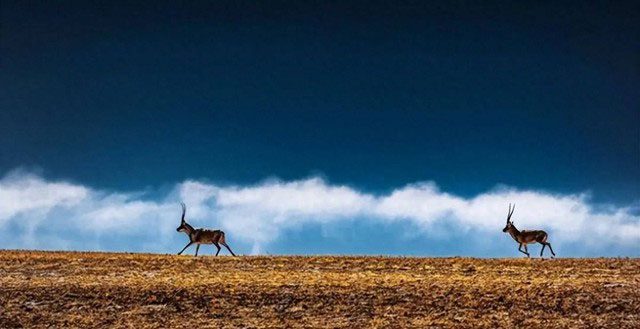Located on the Tibetan Plateau, Hoh Xil has an average elevation exceeding 4,500 meters, with many peaks rising above 6,000 meters. The climate here is extremely harsh, with an annual average temperature of around -5°C, frequent snowfall, and strong winds.
“The Forbidden Zone for Humans”
Firstly, Qinghai Province in China is known as the “Jewel of the Plateau,” and it is one of the most breathtakingly scenic areas. Accordingly, the Hoh Xil National Nature Reserve is considered the largest natural wildlife reserve in China and is dubbed the “forbidden zone for humans.”
The Hoh Xil Nature Reserve covers a total area of nearly 235,000 km2 and is located in the Yushu Tibetan Autonomous Prefecture and the Golok Tibetan Autonomous Prefecture within Qinghai Province.

Hoh Xil is an area with an average altitude above 4,000 meters, featuring towering snow-capped peaks, shimmering glaciers, and crystal-clear lakes. It is home to many rare animal species such as the Tibetan antelope, the Tibetan wild yak, and the snow leopard. The Hoh Xil ecosystem plays a vital role in regulating the local climate, providing water sources for major rivers, and serving as a treasure trove of invaluable natural heritage.
In terms of elevation, Hoh Xil consistently stands above 4,000 meters, sometimes reaching 4,600 meters, and is home to over 7,000 glaciers that feed into the high peaks.
This land is also rich in biodiversity. There are over 2,000 plant species, and the number of wildlife species is substantial—about 230 wildlife species inhabit this land. Furthermore, it features vast high-altitude grasslands and wetlands, as well as unique highland lakes, rivers, and forests.
Due to the abundant wildlife resources in this region, it was designated as an important habitat for wildlife in China and as an inviolable area upon its establishment.

Despite its majestic beauty, Hoh Xil experiences extremely harsh weather conditions. The climate is frigid year-round, with average temperatures ranging from -5°C to 5°C. Winters are long, with heavy snowfall and frequent blizzards. Summers are brief and cool, with low rainfall. The terrain of Hoh Xil is also incredibly rugged, featuring steep mountain slopes, sheer cliffs, and deep ravines. The dense river network has swift currents and poses many dangers. Lack of oxygen is one of the greatest challenges for humans entering Hoh Xil. As altitude increases, oxygen density in the air decreases, making people prone to dizziness, unconsciousness, and even death.
2. How frightening is the “Forbidden Zone for Humans”?
As a land known as the “forbidden zone for humans,” Hoh Xil naturally possesses its own unique characteristics. Firstly, in Hoh Xil, the climate changes rapidly, exhibiting very unstable weather with the phenomenon of “four seasons in one day.”
This is also due to Hoh Xil’s high altitude, with most areas exceeding 4,600 meters, leading to very low temperatures and unstable weather.
In summer, due to extended sunshine lasting 7 or 8 hours, temperatures can still be relatively high, but summer snowfall is also a common occurrence.
When the wind rises in summer, temperatures can drop sharply, creating multiple seasons within a single day. This makes it difficult for people to adapt and increases the risk of altitude sickness. If one wishes to live in Hoh Xil, the most important thing is to adjust one’s mindset and not let the climate disrupt them. This way, life for the inhabitants will become easier.

Due to the harsh conditions and lurking dangers, the Chinese government has prohibited tourists and locals from freely traversing the Hoh Xil area. Movement is only allowed with special permission and the support of experienced guides. However, Hoh Xil still faces potential threats from human activities. The demand for mineral extraction, illegal hunting, and livestock grazing is gradually encroaching on the area, threatening the ecosystem and habitats of rare animals.
Another issue is that the lack of oxygen in Hoh Xil is very serious. When you arrive in this region, you are likely to feel dizzy. Additionally, due to the remote local environment, there are limited basic living conditions.
Moreover, the presence of many wild animals in the area poses significant threats to humans. First are the wild wolves. There are packs of wild wolves in Hoh Xil. They have strong attacking power and are very patient. Once they set their sights on prey, they will not easily give up.
Another threat is the brown bear, a very aggressive animal. They are quite large, and no animal can withstand their attack in this region. Once spotted by a brown bear, survival chances are virtually nonexistent.


















































